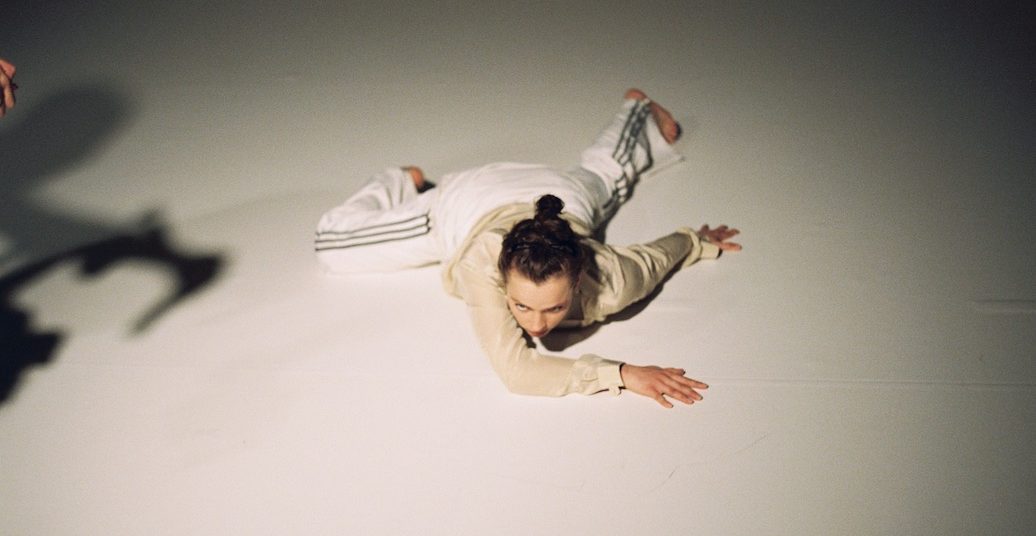The performance series NAH DRAN (CLOSE TO), which began in 2007, has once again presented three new pieces by young Berlin choreographers. They were performed live on 22 & 23 January 2022 at ada Studio and were subsequently available as a video stream for four days. Wholly different in image and sentiment, all pieces were characterized by a sphere of sound, which functioned as a significant element of the choreographic happening on the stage.
Three pieces, one after the other, during one evening of performances. Three different dance approaches, three dissimilar visual experiences, three debates with different topics. First, “Why death was just death” by dancer and choreographer Leila Patzies and musician Bláthin Eckhardt, with its unsettled, dark air. Patzies’ large circular movements lend the performance an expressiveness. However, it is marked by an inward directed spiritual search, which ultimately culminates in exhaustion, depression, and surrender. The word breathlessness comes to mind, especially when breathing sounds can be heard in the space. At the same time, Eckhardt recites text from Haruki Murakami’s novel Tokyo Blues. One sentence from the book that does not appear in the piece says: “When you are surrounded by darkness, the only alternative is to remain motionless until your eyes get used to the darkness.” Patzies appears to fight with the darkness until it remains motionless.
Next up are Lena Reyle and Johanna Seiler with “The Core – the art of speaking one language”. The vocal/improv artist Seiler sings a capella. Sometimes fluid and melodious, sometimes fitful, but always playful and effortless. This effortlessness and the joy of playing is evident in Reyle’s dancing, which has traces of her ballet background. In contrast to the first piece of the evening, her fluid, light, hopping movements exude ease. The two artists harmoniously converge in their expression. However, even more important is that their forms of expression take on a powerful life all their own, without coming into symbiosis.
“funky serenade”, the final piece of the evening – and at the same time the most formal one – is centered around an investigation into the interplay between music, rhythm, and movement. The minimal, probing, and measured (especially arm and hand) movements of Jung Sun Kim, the contrabass experiments by Clara Gervais, and the tape recordings are all driven by the same beat. Within this predetermined framework, Kim and Gervais create almost ritualistic images and sounds. In the process, they speak either a controlled language with clear contours or drop the structure and discover new performative possibilities. In both cases, repetition is used as a creative means of unraveling an equally technical and human process. The word “funky” in the title of the piece not only alludes to a music genre, one characterized by repetitive bass, it also means extraordinary and unconventional, which echoes the nature of the piece equally well.
In this contextually diverse and exhilarating dance program, the quality common to all pieces is the role of music and sounds as equally important stage elements. In “Why death was just death”, we experience this through the live presence of Bláthin Eckhardt. Her atmospheric music, created with guitar and sound devices, and her improvisation with text are by no means a mere accompaniment to the dance. Their intensity steers the mood of the dancer and the piece. “The Core – the art of speaking one language” presents voice and dance as two partners, which each achieve their own separate completeness but are also capable of artistically harmonious collaboration. In “funky serenade”, this equality is already evidenced by the stage setting. Next to a square where the dancer is seated, we see another square with two speakers. Sometimes music and dance hold each other captive. Sometimes they attempt to free themselves of one another. However, they remain ever inseparable. This alternating between a desired dependence and a creative autonomy runs throughout the circa one-hour program and merges the pieces into a coherent whole.
English translation by Melissa Maldonado
NAH DRAN with the performances “Why death was just death” (Leila Patzies & Bláthin Eckhardt), “The Core – the art of speaking one language” (Lena Reyle & Johanna Seiler) and “funky serenade” (Jung Sun Kim, composition: Clara Gervais) could be seen live in the ada Studio on 22/23 January 2022 and was available as a video stream for four days afterwards.
The next edition, NAH DRAN extended: Looking After, will be performed live on 19/20 February 2022, with the recording also available online as a videostream afterwards until 25 February 2022. The virtual visit of the events is free of charge, with the purchase of a .com(munity) ticket they can financially honor the additional work of the ada Studio.




